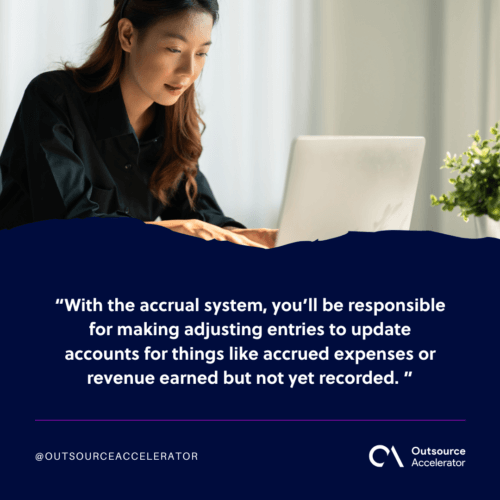Adjusting entries examples and tips for accurate bookkeeping

Adjusting entries are essential for maintaining accurate financial records at the end of an accounting period. These entries are made to update accounts that haven’t been recorded correctly or completely during the regular accounting process.
In simpler terms, they correct discrepancies that arise from timing differences or accruals, helping businesses reflect their true financial position.
Imagine a company that has earned revenue in December for a service provided, but hasn’t yet issued an invoice. Without adjusting entries, the revenue wouldn’t appear on the books until the invoice was sent in January. This could mislead stakeholders about the company’s financial health.
Making an adjusting entry can help the company ensure that the revenue is recognized in December when it was actually earned.
In this article, we’ll highlight five adjusting entries examples, with practical tips for each type, to help you manage your books accurately and effectively.
Who makes adjusting entries?
If you handle your own business’ accounting, the need for adjusting entries depends on the method you use. With the accrual system, you’ll be responsible for making adjusting entries to update accounts for things like accrued expenses or revenue earned but not yet recorded.
This ensures that your financial statements reflect a more accurate picture of your business’s financial situation.

On the other hand, if you use the cash basis system, adjusting entries is typically unnecessary because transactions are only recorded when cash is exchanged.
If you work with an outsourced bookkeeper, you can leave all adjusting entries to them. An outsourced professional bookkeeper will take care of any adjustments needed, regardless of whether you follow the accrual or cash method, allowing you to focus on running your business.
5 Main benefits of adjusting entries
Here are five main benefits of making adjusting entries:
1. Accurate financial reporting
Any type of adjusting entries examples allows businesses to report their financial performance more accurately. They reflect the true state of income and expenses, regardless of when cash transactions occur.
For example, accrued revenues and expenses will be recognized in the period in which they occur, providing a more accurate snapshot of your business’s finances.
2. Compliance with accounting standards
Businesses using the accrual accounting method are required to follow generally accepted accounting principles (GAAP).
Adjusting entries are part of this process and help ensure that financial statements comply with these standards. This is especially important for companies that are publicly traded or seeking investors.
3. Tax benefits
Making proper adjusting entries can help reduce tax liabilities by recognizing certain expenses and liabilities in the correct period.
For example, accrued expenses, such as wages or interest, may be deductible in the current period, lowering taxable income.
4. Better decision-making
With accurate and up-to-date financial data, business owners can make more informed decisions. Whether you’re planning for growth, managing cash flow, or assessing profitability, adjusting entries provide a clearer view of your company’s true financial condition.
5. Improved cash flow management
Adjusting entries allow for better tracking of accounts receivable and payable. This gives a clearer picture of when money is expected to flow in or out, helping you manage financial stream more effectively.

5 adjusting entries examples for each type
There are different types of adjusting entries, each serving a specific purpose:
1. Accrued revenues
Accrued revenues occur when a company earns income but hasn’t yet billed the client or received payment.
For example, if a consultant completes a project in December but doesn’t invoice the client until January, the earned revenue for December should be recorded.
The adjusting entry would be:
Debit: Accounts Receivable
Credit: Revenue
2. Accrued expenses
Accrued expenses are costs that a company has incurred but hasn’t yet paid. For instance, if an employee earns wages in December but is paid in January, the wages should be recorded in December.
The adjusting entry would be:
Debit: Wages Expense
Credit: Wages Payable
3. Deferred revenues
Deferred revenues represent payments received for goods or services not yet provided. For example, if a company receives a 12-month subscription fee in advance for a service, part of the revenue is earned each month.
After the first month, the adjusting entry would be:
Debit: Unearned Revenue
Credit: Revenue
4. Prepaid expenses
Prepaid expenses occur when a company pays for goods or services in advance. For instance, if a company pays an insurance premium for a year in advance, each month, an adjusting entry must be made to recognize the expense.
After one month, the entry would be:
Debit: Insurance Expense
Credit: Prepaid Insurance
5. Depreciation expenses
Depreciation is the allocation of the cost of a long-term asset over its useful life. For example, if a company purchases equipment for $12,000 with a useful life of 12 years, each year, depreciation needs to be recorded.
The annual adjusting entry would be:
Debit: Depreciation Expense
Credit: Accumulated Depreciation
These adjustments help reflect a more accurate financial picture so your financial statements reflect the true condition of the business.







 Independent
Independent




